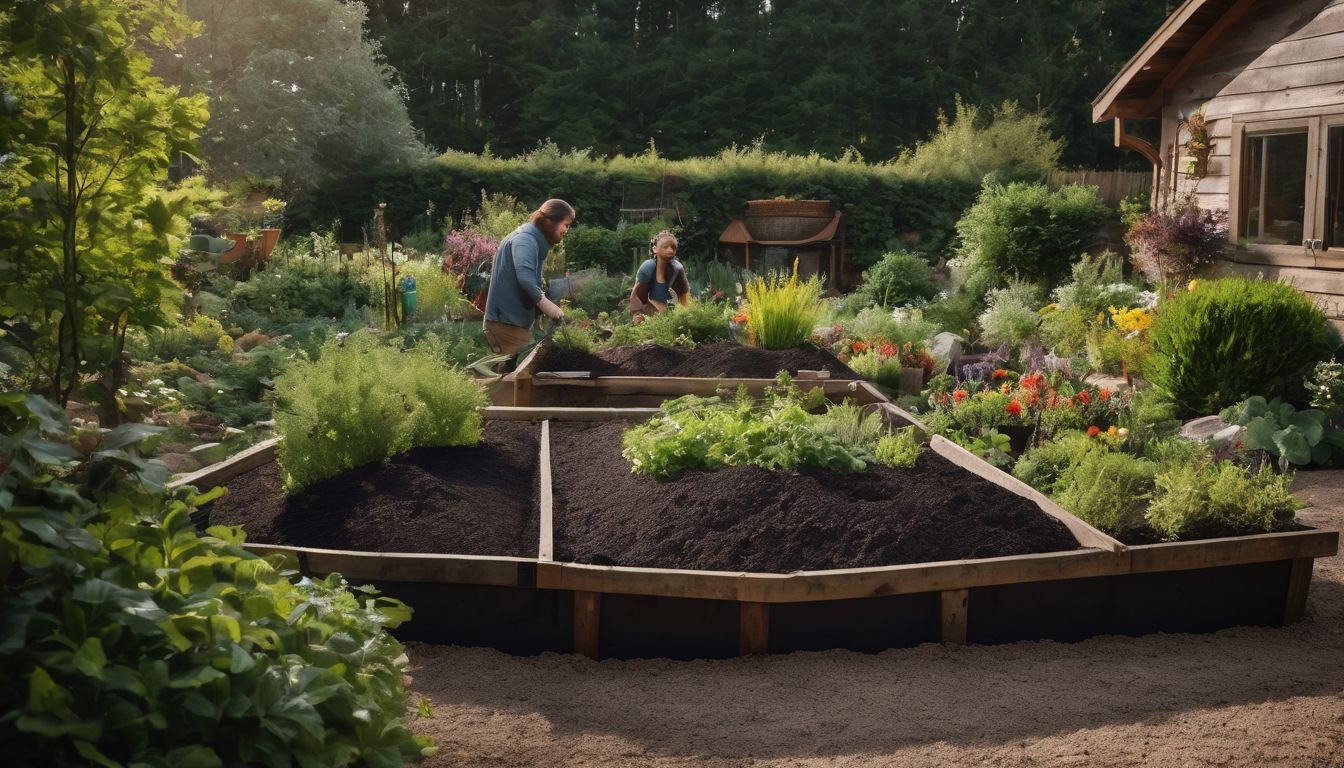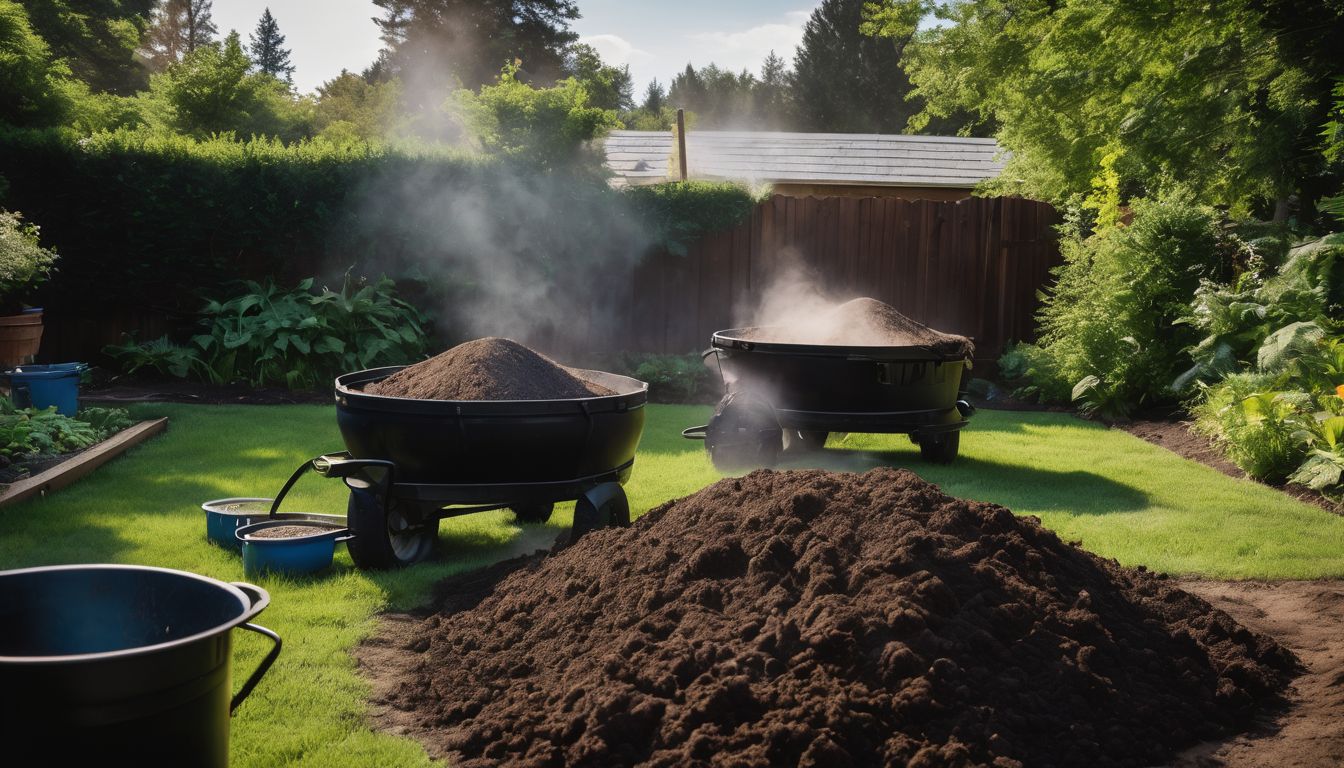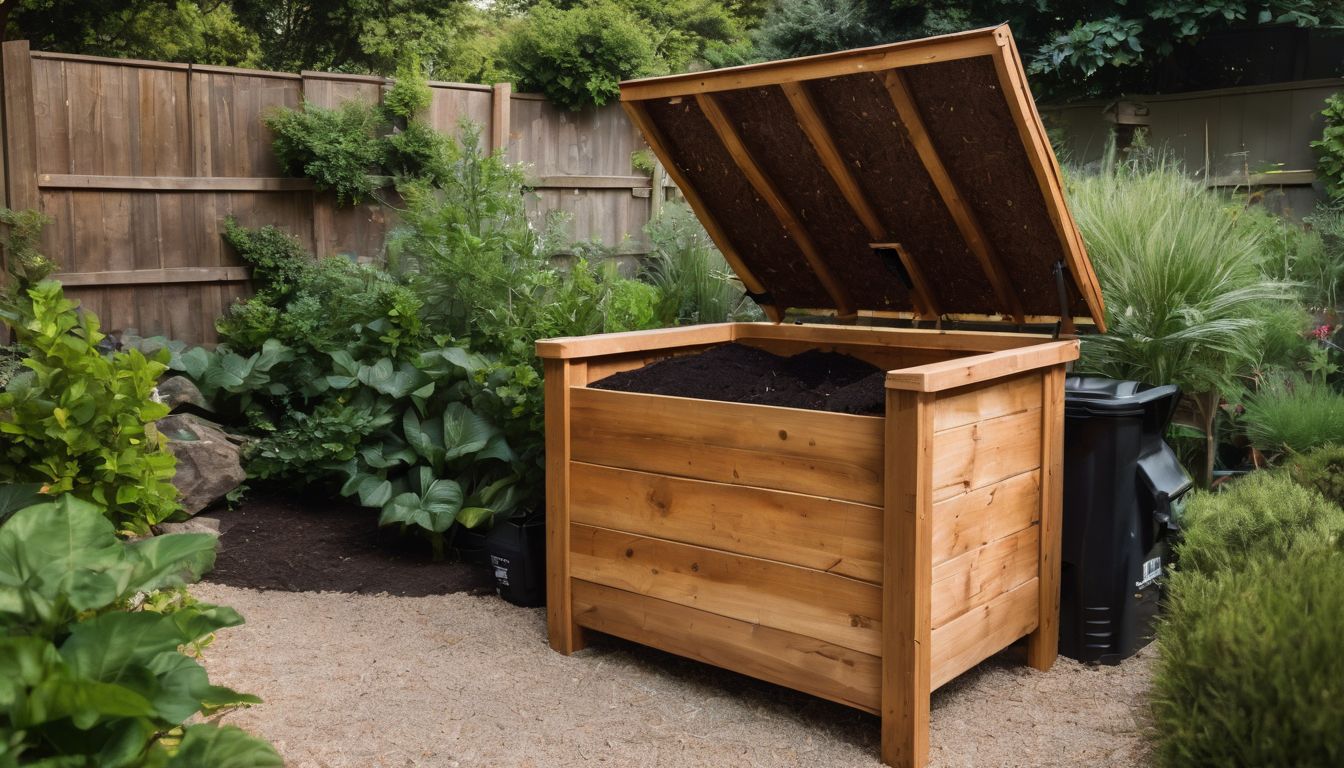Are you tired of tossing your kitchen scraps into the bin? Every year, millions of tonnes of food waste end up in landfills, contributing to greenhouse gas emissions. Our guide will show you how to turn those peels and leftovers into rich compost that can rejuvenate your garden soil.
It’s easy-peasy!
Key Takeaways
- Composting kitchen scraps reduces methane emissions from landfills and cuts down on the use of chemical fertilisers, offering a more sustainable way to enrich garden soil.
- To start composting at home effectively, balance green materials like food waste with brown materials such as leaves or cardboard, maintain correct moisture levels and aerate regularly.
- You can still participate in composting without a yard by using indoor methods like worm bins or Bokashi bins, as well as joining community compost programs.
- Common items suitable for composting include fruit and vegetable peels, coffee grounds, tea leaves, eggshells and nutshells; adding these to your pile contributes valuable nutrients to the finished compost.
- Utilise homemade compost in your garden by adding it around plants or into planting holes to improve soil health naturally, avoiding excess waste and enhancing plant growth.
Understanding the Benefits of Composting
Composting kitchen scraps not only reduces waste and your carbon footprint, but also improves soil health, plant growth, and saves money on fertilisers. It’s a simple yet effective way to support environmental sustainability and make the most of organic waste.
Reducing waste and carbon footprint
Every time we toss out leftover food or kitchen scraps, they end up in landfills where they decompose anaerobically, releasing methane—a potent greenhouse gas. By turning our kitchen waste into compost instead of sending it to a landfill, we sharply cut down on these harmful emissions.
Not only do composting practices trim down the volume of rubbish needing transport and disposal, but they also reduce the need for synthetic fertilisers which have their own carbon-intensive manufacturing and shipping footprint.
Engaging in home composting means you’re actively recycling organic material that nourishes soil life. This natural process converts your peels and leaves into a rich additive that boosts plant growth without relying on chemical alternatives.
Kitchen composting turns waste reduction into a positive cycle: less refuse going to the dump equals smaller carbon footprints, healthier gardens thrive under the care of homemade compost – all moving towards more sustainable living habits.
Improving soil health and plant growth
To further support environmental sustainability, composting kitchen scraps not only reduces waste but also enhances soil health and promotes plant growth. Nutrient-rich compost acts as a natural fertiliser, enriching the soil with essential minerals and organic matter that plants need to thrive.
This process helps improve soil structure, water retention, and microbial activity, leading to healthier plants with stronger root systems and increased resistance to pests and diseases.
By incorporating compost into your gardening practices, you can contribute to the overall vitality of your garden while reducing the reliance on commercial fertilisers.
Furthermore, composting fosters a balanced ecosystem in the soil by promoting beneficial microorganisms that aid in nutrient cycling and create an optimal environment for plant roots.
Saving money on fertilizers
Improving soil health and plant growth naturally reduces the need for store-bought fertilisers, saving you money in the long run. By composting kitchen scraps, you can create nutrient-rich organic materials that act as natural fertilisers for your garden.
This not only saves on expenses but also promotes sustainable and eco-friendly gardening practices. Composting food waste at home offers a cost-effective way to enrich your soil, reduce reliance on synthetic fertilisers, and contribute to a healthier environment.
By utilising homemade compost from kitchen scraps instead of buying commercial fertilisers, you’ll be supporting sustainable practices while saving money in the process.
How to Compost in a Yard
Find a suitable location in your yard for composting, away from direct sunlight and excess moisture. Build a compost bin using materials such as wood, wire mesh or plastic. Add the right balance of green and brown materials to your compost bin to start the decomposition process.
Choosing the right location
Position your compost bin in a convenient spot, preferably close to the kitchen for easy access. Ensure it is on level ground and receives ample sunlight for efficient decomposition.
Avoid placing the bin directly on grass or soil to prevent pests from tunneling into it. Opt for an area with good drainage to prevent waterlogging, which can hinder the composting process.
Additionally, choose a location away from strong winds and heavy rainfall to maintain proper moisture levels within the compost.
Building a compost bin
To build a compost bin, gather recycled wood or purchase a ready-made one. Measure and cut the wood to your desired dimensions for the bin structure. Assemble the pieces using nails or screws, ensuring stability.
Position the bin in a convenient location in your yard, preferably near where you’ll dispose of kitchen scraps.
Once built, start layering green and brown organic materials inside the bin – think fruit and vegetable scraps, coffee grounds, tea leaves (green), along with dry leaves and straw (brown).
Ensure good airflow by adding small sticks or twigs to create air pockets within the layers. Keep turning and mixing these materials regularly to encourage decomposition.
Adding the right materials
To create nutrient-rich compost, it is important to add the right materials. By balancing carbon-rich and nitrogen-rich ingredients, you can achieve a healthy compost pile. Here’s what to include:
- Carbon – rich materials such as dry leaves, straw, paper, and cardboard provide the foundation for your compost.
- Nitrogen – rich materials like fruit and vegetable scraps, coffee grounds, and grass clippings help speed up decomposition.
- Aerate the pile with occasional turnings or by adding shredded newspaper to maintain oxygen levels.
- Ensure proper moisture by adding water when necessary but avoid making the compost too wet.
- Avoid adding meat, dairy products, oils, and pet waste to prevent unpleasant smells and attracting pests.
Composting Without a Yard
If you don’t have a yard, there are still options for composting your kitchen scraps, such as indoor composting methods, community composting programs, and Bokashi composting. Read on to find out more about how you can recycle food waste without a yard.
Indoor composting methods
Indoor composting methods are perfect for those without a yard. You can use a worm bin, also known as vermicomposting. In this method, worms break down organic matter, creating nutrient-rich compost. Another option is Bokashi composting, which ferments kitchen scraps using beneficial microorganisms. You can also consider using a compost tumbler in a garage or balcony to efficiently compost kitchen waste. Additionally, try aerobic composting with a specialised indoor composter that accelerates the process using heat and oxygen. A final alternative is electric composters that use heat and agitation to quickly break down organic matter – perfect for small spaces.
Community composting programs
Community composting programs offer a convenient solution for those without yard space or the time to manage their own compost. Participating in these initiatives allows individuals to divert food waste from landfills, reducing methane emissions and creating nutrient-rich soil.
In addition, community programs provide an opportunity to connect with like-minded individuals and contribute to a collective effort towards environmental sustainability.
Moreover, community composting programs promote education and awareness about the importance of organic waste recycling. Participants can learn valuable techniques for managing household food scraps while actively contributing to local environmental conservation efforts.
Bokashi composting
Moving on from community composting programs, another effective method for composting kitchen scraps without a yard is Bokashi composting. This method involves fermenting food waste using a mix of microorganisms that break down organic matter in an anaerobic environment.
Bokashi bins are compact and suitable for small spaces, making them ideal for apartment dwellers or those with limited outdoor space. The fermentation process allows for the breakdown of a wider range of materials such as dairy, meat, and cooked foods which may not be suitable for traditional compost piles.
Bokashi composting provides an eco-friendly way to manage kitchen waste while producing nutrient-rich soil conditioner that can be used to enrich indoor plants or balcony gardens. Moreover, it reduces methane emissions produced by decomposing food waste in landfills, contributing to environmental conservation efforts.
What Can Be Composted
Common kitchen scraps such as fruits and vegetable peels, coffee grounds, tea leaves, eggshells, and nutshells can all be composted to create nutrient-rich soil for your garden. Composting these materials reduces waste in landfill and provides natural fertilisers for plants.
Fruits and vegetable scraps
Fruits and vegetable scraps break down quickly in a compost pile. They provide essential nutrients that enrich the soil, promoting healthy plant growth. Ensure to chop them into small pieces before adding them to your compost bin.
Doing so speeds up the decomposition process and prevents any unwelcome odors from forming.
To maintain a balanced compost, include a variety of fruit and vegetable scraps such as apple cores, banana peels, carrot tops, and lettuce leaves. Remember to avoid citrus fruits and onions as they can slow down the decomposition process.
Coffee grounds and tea leaves
After composting fruits and vegetable scraps, consider adding coffee grounds and tea leaves to your compost pile. These kitchen waste items are rich in nitrogen, which aids in the decomposition process.
Coffee grounds also help improve the soil structure and water retention while tea leaves add organic matter to the compost. Both substances deter pests due to their strong odours.
Mix these materials into your compost heap regularly or directly sprinkle them around plants as a natural fertiliser. Over time, they will break down, enriching your soil with valuable nutrients for healthy plant growth without harming the environment.
Eggshells and nutshells
Crushed eggshells and nutshells are great additions to your compost pile, providing essential nutrients like calcium and potassium. Simply rinse and air-dry the shells before crushing them into small pieces.
These materials help to balance the acidity levels in your compost, creating an optimal environment for beneficial microorganisms. As they break down, they contribute valuable minerals to the finished compost, aiding in soil enrichment when used in your garden or potted plants.
Ground eggshells also act as a natural pest deterrent due to their sharp edges, keeping unwanted pests away from your precious plants without harming beneficial insects. Nutshells add texture to the compost while slowly releasing nutrients over time, making them a valuable addition for healthy plant growth.
Tips and Tricks
– Keep a good balance of green and brown materials to ensure a healthy compost pile.
– Speed up the composting process by shredding or chopping your kitchen scraps before adding them to the pile.
Maintaining proper balance of materials
To ensure successful composting, it’s essential to maintain a proper balance of materials. Balancing “greens” like fruit and vegetable scraps with “browns” such as dry leaves or shredded paper helps provide the ideal environment for decomposition.
This balance creates the right mix of nitrogen and carbon, supporting the growth of beneficial microorganisms that break down the organic matter into nutrient-rich compost. Regularly turning or mixing the pile also helps aerate the materials, facilitating the process and reducing unpleasant odors.
Monitoring moisture levels is another crucial aspect of maintaining a balanced compost pile. It’s important to keep it damp but not waterlogged; this ensures that decomposition occurs at an optimal pace without creating a smelly or slimy environment.
Speeding up the composting process
To speed up the composting process, regularly turn or aerate the compost pile to provide oxygen to the microorganisms breaking down the materials. Adding nitrogen-rich materials such as grass clippings, coffee grounds, or vegetable scraps can also accelerate decomposition.
Keep the compost moist but not waterlogged and monitor its temperature to ensure it remains within the ideal range for microbial activity. Consider using a compost accelerator containing beneficial microorganisms to hasten decomposition further and produce rich, fertile compost for your garden.
Employing these techniques can expedite the transformation of kitchen scraps into nutrient-rich organic matter, reducing waste while enhancing soil health and plant growth in an environmentally sustainable manner.
Troubleshooting common issues
If your compost pile smells bad, it might be too wet or have anaerobic pockets. To solve this, add dry materials like leaves or shredded paper and turn the pile to aerate it.
Pests in your compost can be a sign that you’re adding the wrong items. Avoid putting meat, dairy, or fatty foods into your compost and bury kitchen scraps under several inches of soil to deter pests.
When mold appears on your heap of compost, it’s usually an indication that it’s too moist and lacks airflow. Add dry materials and fluff up the pile to help mold diminish.
Using compost in your garden
Enhance your garden by incorporating nutrient-rich compost. Spread a layer of compost around the base of your plants, flowers, and vegetables to provide essential nourishment for healthy growth.
Mix the compost into the soil when planting new seeds or transplants to improve soil structure and water retention, allowing for better root development. Additionally, create a homemade natural fertiliser by steeping compost in water to make a potent liquid plant feed.
Regularly using compost in your garden contributes to sustainable gardening practices while reducing the need for chemical-based fertilisers.
Conclusion
In summary, composting kitchen scraps is a simple way to reduce waste and create natural fertiliser. It’s an eco-friendly practice that benefits the environment and your garden. By following these tips, you can easily turn food waste into nutrient-rich compost for your plants.
Start composting today and make a positive impact on the planet while enjoying healthier soil and greener gardens. Join the movement of environmentally conscious individuals who are taking steps towards sustainable living through kitchen waste recycling.
FAQs
1. What is composting kitchen waste, and why should I do it?
Composting kitchen waste turns food scraps into natural fertiliser, helping you manage food waste and adopt eco-friendly kitchen practices.
2. Can I start composting food scraps if I don’t have a yard?
Certainly! You can compost food waste without a yard by using methods such as indoor bins or worm composting systems, perfect for a flat setting.
3. What are the basics of making compost from my kitchen scraps?
To make compost from your kitchen scraps, mix greens like vegetable peelings with browns like dry leaves, ensure proper moisture levels, and turn regularly to aid decomposition.
4. Are there any tips for beginners on how to effectively do household composting?
For beginners in household composting: start small with everyday food scraps, avoid meat and dairy products in your pile, and maintain a balance between wet and dry materials.
5. How does DIY composting help with green living at home?
DIY composting reduces landfill-bound waste by recycling your kitchen leftovers into valuable organic matter that enhances soil health – it’s a cornerstone of green living.





